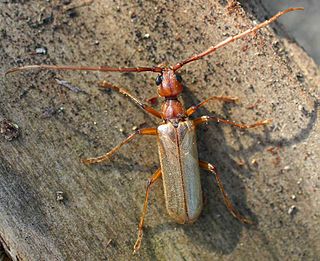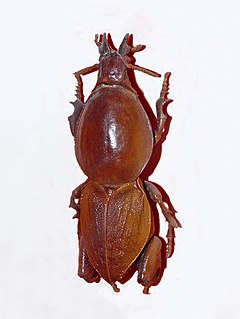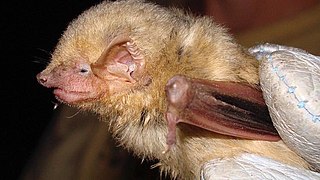
Vespertilionidae is a family of microbats, of the order Chiroptera, flying, insect-eating mammals variously described as the common, vesper, or simple nosed bats. The vespertilionid family is the most diverse and widely distributed of bat families, specialised in many forms to occupy a range of habitats and ecological circumstances, and it is frequently observed or the subject of research. The facial features of the species are often simple, as they mainly rely on vocally emitted echolocation. The tails of the species are enclosed by the lower flight membranes between the legs. Over 300 species are distributed all over the world, on every continent except Antarctica. It owes its name to the genus Vespertilio, which takes its name from a word for bat, vespertilio, derived from the Latin term vesper meaning 'evening'; they are termed "evening bats" and were once referred to as "evening birds".

The longhorn beetles (Cerambycidae), also known as long-horned or longicorns, are a large family of beetles, with over 35,000 species described. Most species are characterized by extremely long antennae, which are often as long as or longer than the beetle's body. In various members of the family, however, the antennae are quite short and such species can be difficult to distinguish from related beetle families such as the Chrysomelidae. The scientific name of this beetle family goes back to a figure from Greek mythology: after an argument with nymphs, the shepherd Cerambus was transformed into a large beetle with horns.

Harpalinae is a huge subfamily of ground beetles that contains 20,000 species or ~6,400 spp. in 24 tribes worldwide, according to others. A rarely used common name for the subfamily is the harp beetles. The Harpalinae contain the most apomorphic ground beetles, displaying a wide range of forms and behaviors. Some are, rare among ground beetles, omnivores or even herbivores.

The Chrysomeloidea are an enormous superfamily of beetles, with tens of thousands of species, mostly in the families Cerambycidae and Chrysomelidae, the leaf beetles.

Lamiinae, commonly called flat-faced longhorns, are a subfamily of the longhorn beetle family (Cerambycidae). The subfamily includes over 750 genera, rivaled in diversity within the family only by the subfamily Cerambycinae.

The Disteniidae are a small family of beetles in the superfamily Chrysomeloidea, traditionally treated as a group within the Cerambycidae.

The Vesperidae are a small family of beetles, normally classified within the family Cerambycidae, of heterogeneous aspect but all characterised by larval stages related to roots of herbaceous plants or trees

Trachyderini is a tribe of long-horned beetles in the family Cerambycidae. There are at least 140 genera and 650 described species in Trachyderini.
Crioprosopus is a genus of long-horned beetles in the family Cerambycidae. There are about 13 described species in Crioprosopus.
Crioprosopus thoracicus is a species of long-horned beetle in the family Cerambycidae. It was described by Henry Walter Bates in 1892.

Hypocephalus armatus, the mole beetle, is a species of beetle in the family Vesperidae. It is the only species in the genus Hypocephalus. Both the genus and species were first described by Anselme Gaëtan Desmarest in 1832. It is found in Brazil and is popular in museums and collections for its curiosity value and adaptations to digging in soil that make them appear outwardly similar to the mole crickets.
Holopleura is a genus of long-horned beetles in the family Cerambycidae. It is the only genus in the tribe Holopleurini. There is at least one described species in Holopleura, H. marginata.

Tetropium is a genus of long-horned beetles in the family Cerambycidae. There are at least 20 described species in Tetropium.
Neospondylis is a genus of long-horned beetles in the family Cerambycidae. There are at least two described species in Neospondylis.

Aeorestes is a genus or subgenus of vesper bat commonly known as the hoary bats. As a genus, it includes species that were formerly included in the genus Lasiurus.
Callistochroma is a genus of long-horned beetles in the family Cerambycidae. There are about seven described species in Callistochroma.
Pilostenaspis is a genus of long-horned beetles in the family Cerambycidae. There are at least three described species in Pilostenaspis.

Dasypterus is a genus of or subgenus of vesper bat. As a genus, it includes species that were formerly in the genus Lasiurus. Collectively, members of Dasypterus are referred to as the yellow bats.

The Rousettinae are a subfamily of megabats. Taxa within this subfamily include:
Bostrychopsebium usurpator is a species of longhorn beetle endemic to Sri Lanka.













